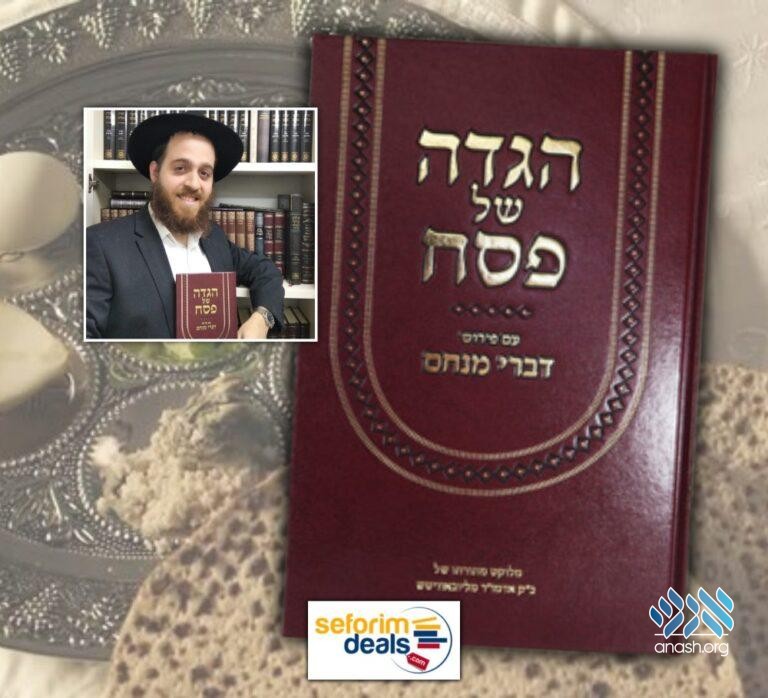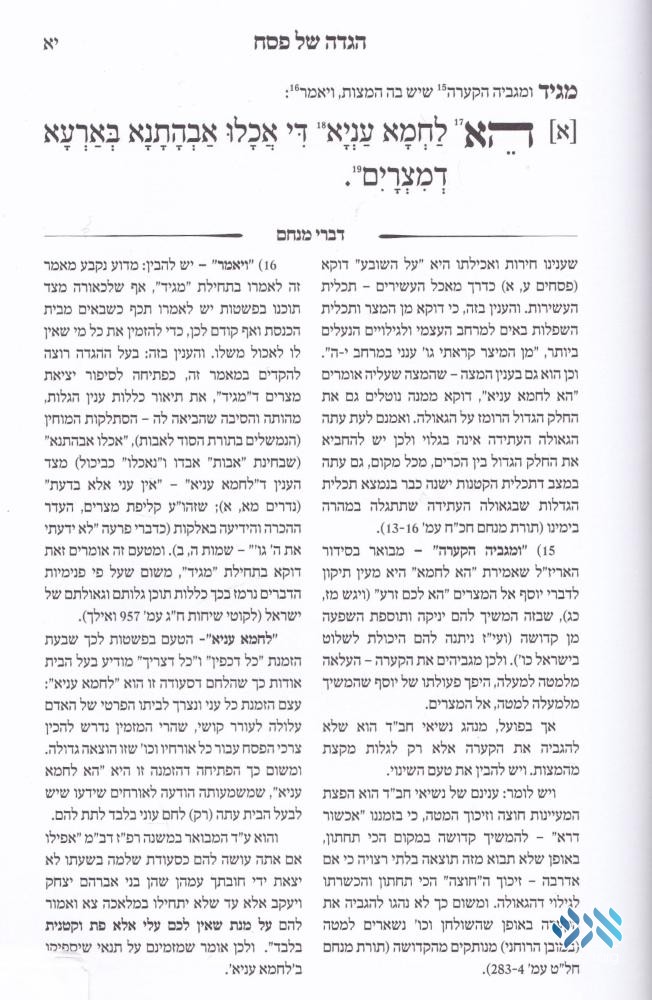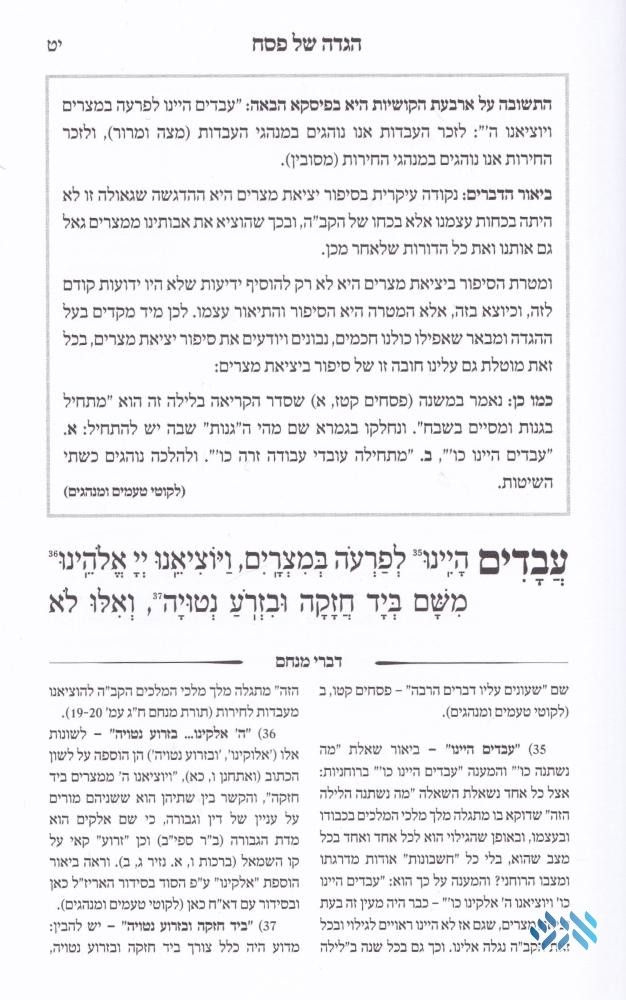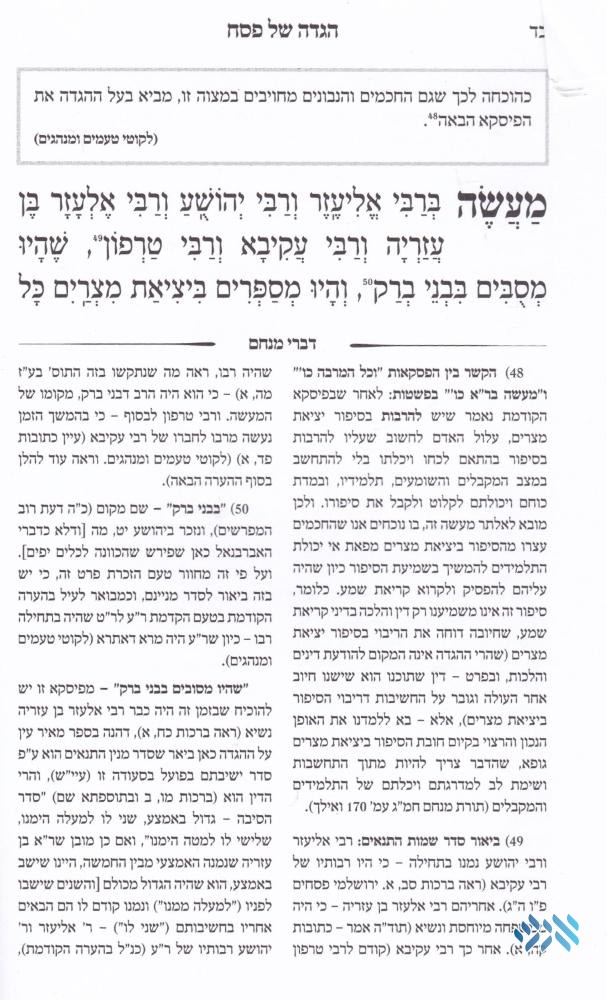A Look Inside the Book: Many seforim have been authored on the Rebbe’s Haggadah. But they only represent the first layer of the Rebbe’s chidushim. A new Haggadah attempts to give the broader picture.
By Shmuel Super
Haggadah Shel Pesach im Pirush Divrei Menachem
Editor: Rabbi Chanina Beindman
Kehot Publication Society, 5781
91 pages
In 5706 the Rebbe published his first sefer, the Haggadah Shel Pesach im Likutei Taamim Uminhagim. While around 200 volumes of the Rebbe’s Torah has been published in the subsequent years, the Haggadah remains the only sefer that the Rebbe wrote and published himself, and as such it is especially treasured by Chassidim.
(As an aside, it is interesting to note that the Rebbe’s Haggadah was not the first standalone Chabad Haggadah published. This distinction belongs to Sod Kedoshim, a Haggadah first published in 5626 with the text of the Haggadah flanked by maamarim of the Alter Rebbe on one side, and maamarim of R. Aharon Halevi of Strashele on the other side.)
The Rebbe’s Haggadah was enthusiastically received by the Torah world in general (for R. Zevin’s review, see here) and it is of course a staple on every Lubavitcher seder table. A number of seforim and lengthy articles have been written on the Rebbe’s Haggadah, uncovering the many chidushim contained in its brief and concise words.
But the Rebbe’s original Haggadah only represents the first layer of the Rebbe’s chidushim and biurim of the Haggadah. In the years following its publication the Rebbe said and wrote many more explanations on the Haggadah. Many of these were delivered at the special farbrengen the Rebbe held every year from 5711 until 5730 after the second seder. And of course, other biurim are spread out among the many volumes of the Rebbe’s sichos, Igros Kodesh, and Reshimos.
As a result, beginning in 5733 new editions of the Rebbe’s Haggadah were published, each of which added more of the biurim available at that time as hosafos to the original Haggadah. The final Kehos edition of the Haggadah published in 5762 contains over 100 pages of additional biurim to the Haggadah, organized according to the order of the Haggadah. This edition includes primarily the mugah sichos published in Likutei Sichos, and the sichos appear in their original form—many in Yiddish—with the full lengthy analysis and discussion.
The popular Heichal Menachem – Kehos 5759 edition of the Haggadah includes a 70 page supplement titled Shaarei Haggadah. This likut includes biurim from a wider range of sources, such as non-mugah sichos and Reshimos. The biurim are all translated into Hebrew and edited in order to focus more directly on the words of the Haggadah itself.
Another noteworthy Chabad Haggadah was published by Machon Or Hachasidus in 5774, titled Otzros Hahaggadah. While the Haggados mentioned previously all include the original text of the Rebbe’s Haggadah followed by a separate section of additional biurim, this Haggadah combines biurim from all of the different sources, published on the page with the Haggadah. Here too, the biurim are all translated into Hebrew and edited. This edition only includes chidushim and biurim, leaving out the many brief comments and references in the Rebbe’s original Haggadah.
This year, Divrei Menachem, a new Haggadah with the Rebbe’s biurim, has been published by Kehos. The editor of this Haggadah is R. Chanina Beindman, a yungerman in Eretz Yisrael who has already published two other seforim—on the Rebbe’s Hayom Yom and a guide for teaching Gemara to younger students. The format of this Haggadah includes the text of the Haggadah at the top of the page with footnotes referencing the pirush Divrei Menachem at the bottom. The upper section of the text of the Haggadah itself also includes boxed texts are incorporated between paragraphs of the Haggadah with biurim, excerpted mainly from the Rebbe’s original Haggadah, that explain the flow of the Haggadah—the connection between the paragraphs. The sefer is well designed and easy to use, and the commentary is written in a clear, classical Hebrew.
A comparison with the aforementioned Haggados shows two major points of difference that distinguish Divrei Menachem. Firstly, Divrei Menachem draws on significantly more sources in the Rebbe’s Torah for the biurim. However, a close examination shows that even Divrei Menachem is not fully comprehensive, and some biurim included in the other Haggados are missing here (for example, the sichah from Likutei Sichos, vol. 2, p. 539 explaining Maaseh Berabbi Elazar is missing).
Secondly, the biurim in Divrei Menachem are summarized very briefly, presented as a commentary on the Haggadah, rather than as selections from sichos etc. To this end, the buildup of the original sichos etc. with the questions, answers, and broader discussion are omitted, and only the basic point as it explains the text of the Haggadah is included. Here too, only biurim that explain the meaning of the Haggadah are included, so the pieces from the Rebbe’s original Haggadah contain references, comparison of nuschaos, etc. are omitted.
This makes Divrei Menachem ideal for use at the seder table and for the purpose of a general review of the Rebbe’s perspective on the Haggadah. For deeper study of the Rebbe’s biurim the other Haggados mentioned have an advantage, but for those that wish to read the Haggadah and see in it what the Rebbe did, Divrei Menachem is the Haggadah of choice.
Divrei Menachem can be purchased at SeforimDeals.com.
Free shipping on all orders $47 and up in the US!




Discussion
In keeping in line with the Rabbonim's policies for websites, we do not allow comments. However, our Rabbonim have approved of including input on articles of substance (Torah, history, memories etc.)
We appreciate your feedback. If you have any additional information to contribute to this article, it will be added below.